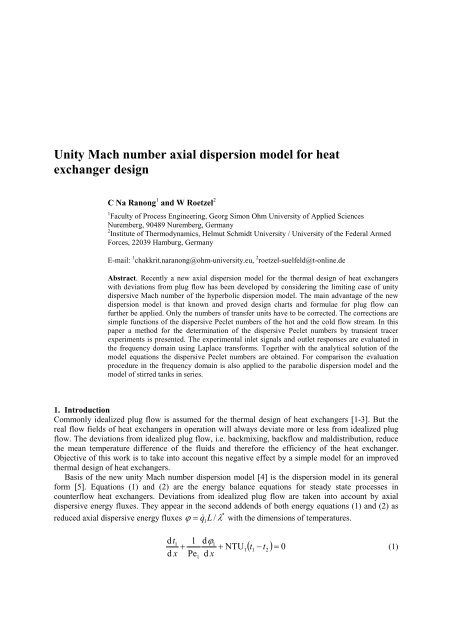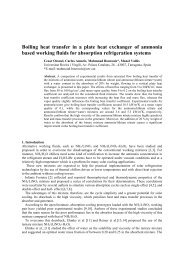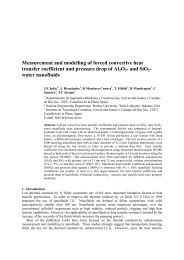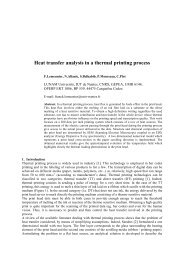Unity Mach number axial dispersion model for heat exchanger design
Unity Mach number axial dispersion model for heat exchanger design
Unity Mach number axial dispersion model for heat exchanger design
You also want an ePaper? Increase the reach of your titles
YUMPU automatically turns print PDFs into web optimized ePapers that Google loves.
<strong>Unity</strong> <strong>Mach</strong> <strong>number</strong> <strong>axial</strong> <strong>dispersion</strong> <strong>model</strong> <strong>for</strong> <strong>heat</strong><strong>exchanger</strong> <strong>design</strong>C Na Ranong 1 and W Roetzel 21 Faculty of Process Engineering, Georg Simon Ohm University of Applied SciencesNuremberg, 90489 Nuremberg, Germany2 Institute of Thermodynamics, Helmut Schmidt University / University of the Federal ArmedForces, 22039 Hamburg, GermanyE-mail: 1 chakkrit.naranong@ohm-university.eu, 2 roetzel-suelfeld@t-online.deAbstract. Recently a new <strong>axial</strong> <strong>dispersion</strong> <strong>model</strong> <strong>for</strong> the thermal <strong>design</strong> of <strong>heat</strong> <strong>exchanger</strong>swith deviations from plug flow has been developed by considering the limiting case of unitydispersive <strong>Mach</strong> <strong>number</strong> of the hyperbolic <strong>dispersion</strong> <strong>model</strong>. The main advantage of the new<strong>dispersion</strong> <strong>model</strong> is that known and proved <strong>design</strong> charts and <strong>for</strong>mulae <strong>for</strong> plug flow canfurther be applied. Only the <strong>number</strong>s of transfer units have to be corrected. The corrections aresimple functions of the dispersive Peclet <strong>number</strong>s of the hot and the cold flow stream. In thispaper a method <strong>for</strong> the determination of the dispersive Peclet <strong>number</strong>s by transient tracerexperiments is presented. The experimental inlet signals and outlet responses are evaluated inthe frequency domain using Laplace trans<strong>for</strong>ms. Together with the analytical solution of the<strong>model</strong> equations the dispersive Peclet <strong>number</strong>s are obtained. For comparison the evaluationprocedure in the frequency domain is also applied to the parabolic <strong>dispersion</strong> <strong>model</strong> and the<strong>model</strong> of stirred tanks in series.1. IntroductionCommonly idealized plug flow is assumed <strong>for</strong> the thermal <strong>design</strong> of <strong>heat</strong> <strong>exchanger</strong>s [1-3]. But thereal flow fields of <strong>heat</strong> <strong>exchanger</strong>s in operation will always deviate more or less from idealized plugflow. The deviations from idealized plug flow, i.e. backmixing, backflow and maldistribution, reducethe mean temperature difference of the fluids and there<strong>for</strong>e the efficiency of the <strong>heat</strong> <strong>exchanger</strong>.Objective of this work is to take into account this negative effect by a simple <strong>model</strong> <strong>for</strong> an improvedthermal <strong>design</strong> of <strong>heat</strong> <strong>exchanger</strong>s.Basis of the new unity <strong>Mach</strong> <strong>number</strong> <strong>dispersion</strong> <strong>model</strong> [4] is the <strong>dispersion</strong> <strong>model</strong> in its general<strong>for</strong>m [5]. Equations (1) and (2) are the energy balance equations <strong>for</strong> steady state processes incounterflow <strong>heat</strong> <strong>exchanger</strong>s. Deviations from idealized plug flow are taken into account by <strong>axial</strong>dispersive energy fluxes. They appear in the second addends of both energy equations (1) and (2) as*reduced <strong>axial</strong> dispersive energy fluxes ϕ = L / λ with the dimensions of temperatures.q ldt1 dϕ1+ +1t1− td x Pe d xNTU ( ) 012=1(1)
dt2 1 dϕ2− + NTU2 1 2=d x Pe d x2( t − t ) 0(2)For the <strong>axial</strong> dispersive energy fluxes an empirical approach, equations (3) and (4), has beendeveloped on the basis of the hyperbolic <strong>heat</strong> conduction law [6, 7].2M1dϕ1d t1ϕ1+ = −(3)Pe d x d x12M2dϕ2dt2ϕ2− = −(4)Pe d x d x2The general hyperbolic <strong>dispersion</strong> <strong>model</strong> contains four parameters M 1 , M 2 , Pe 1 and Pe 2 , i.e. twodispersive Peclet <strong>number</strong>s and two dispersive thermal <strong>Mach</strong> <strong>number</strong>s [8 – 10]. The dispersive Peclet<strong>number</strong> is given byρcp*wLPe = . (5)λThe property λ * is an apparent thermal conductivity which is composed of the molecularconductivity and the convective dispersive contribution due to backflow, backmixing andmaldistribution. The molecular part is a fluid property and the convective one a flow property.Normally the molecular contribution is negligible.The dispersive thermal <strong>Mach</strong> <strong>number</strong> is given bywM = . (6)CFor pure convective phenomena of backflow, backmixing and maldistribution it can be expectedthat the propagation velocity of thermal disturbances C is in the order of the mean flow velocity w. Forpure molecular <strong>axial</strong> <strong>heat</strong> conduction according to Fourier’s law the propagation velocity of thermaldisturbances is infinite and M = 0. Table 1 shows the appropriate regions of application of the different<strong>dispersion</strong> <strong>model</strong>s with respect to the dispersive thermal <strong>Mach</strong> <strong>number</strong>, although all <strong>model</strong>s can beapplied to arbitrary deviations from plug flow depending on the required accuracy [11 – 14].Table 1. Appropriate application of the <strong>dispersion</strong> <strong>model</strong>s according to M.M type appropriate application0 parabolic <strong>axial</strong> <strong>heat</strong> conduction as in liquid metals0 < M < 1 hyperbolic pure backmixing and backflowM > 1 hyperbolic pure maldistribution in tube bundles or plate <strong>heat</strong> <strong>exchanger</strong>s2. <strong>Unity</strong> <strong>Mach</strong> <strong>number</strong> <strong>dispersion</strong> <strong>model</strong>The analytical solution (M ≠ 1) even <strong>for</strong> the simple case of only one dispersive stream in acounterflow <strong>heat</strong> <strong>exchanger</strong> is very complicated and not suited <strong>for</strong> practical <strong>design</strong> calculations [9, 10].Thus a simplified less accurate <strong>model</strong> with a single fixed value of the thermal dispersive <strong>Mach</strong> <strong>number</strong>is more appropriate. Since in industrial <strong>heat</strong> <strong>exchanger</strong>s backmixing and backflow (M < 1) [9] as wellas maldistribution (M > 1) [9] takes place simultaneously, the value M = 1 seems to be a realistic mean
value which is at least better than M = 0 of the parabolic <strong>model</strong>. The special case M = 1 of thehyperbolic <strong>axial</strong> <strong>dispersion</strong> <strong>model</strong> is considered in the following. In equations (3) and (4) it becomesM 2 = 1.Figure 1. Temperature profiles in case of counterflow, NTU 1 =5, Pe 1 = 7, NTU 2 = 3, Pe 2 =10. NTU 1,d = 2.48 and NTU 2,d =1.49.To solve the governing equations (1) – (4) <strong>for</strong> the four dependent variables t 1 , t 2 , ϕ 1 and ϕ 2 onlytwo boundary conditions are necessary. The energy balance requires temperature jumps between thenon-dispersive region outside the <strong>heat</strong> <strong>exchanger</strong> and the dispersive region inside the <strong>heat</strong> <strong>exchanger</strong>(Figure 1). With given inlet temperatures of the fluids the two boundary conditions areT′=t11( x = 0)( x = 0)ϕ1+Pe1(7)andT′= t22( x = 1)ϕ2−Pe( x = 1)Finally, the outlet temperatures are calculated with exit conditions (9) and (10).2. (8)T′′=t21T′′=t21( x = 1)( x = 0)( x = 1)ϕ1+Pe1ϕ2−Pe( x = 0)2(9)(10)
3. Alternative <strong>for</strong>mulation of the governing equationsThe main advantage of the new <strong>model</strong> becomes obvious if the governing equations (1) – (4) are<strong>for</strong>mulated in an alternative way by introducing hypothetic temperatures T 1 (x) and T 2 (x) according toequations (11) and (12). The results are equations (13) and (14).ϕ1T1= t1+(11)Pe1ϕ2T2= t2−(12)Pe2dT1+ NTU1,d xdT2+ NTUd xd2, d( T −T)1= 0( T −T) = 0221(13)NTUiNTUi , d= , i = 1,2(14)NTU1NTU21++Pe Pe1Equation (13) has the mathematical <strong>for</strong>m of the well-known energy equations of non-dispersiveplug flow. This means that known analytical solutions and <strong>design</strong> charts [1 – 3] can be used and thatthe <strong>dispersion</strong> effect can be accounted <strong>for</strong> solely by a correction of the <strong>number</strong> of transfer unitsaccording to equation (14). Figure 1 also shows the hypothetic temperatures which can be interpretedas the temperature profiles in an equivalent non-dispersive plug flow <strong>heat</strong> <strong>exchanger</strong>.Corresponding considerations [4] show that corrections (14) are also exactly valid <strong>for</strong> parallel flowand pure cross-flow. For other flow configurations the correction (14) yields sufficiently accurateapproximations [4]. The unity <strong>Mach</strong> <strong>number</strong> <strong>dispersion</strong> <strong>model</strong> has two parameters Pe 1 and Pe 2 . Itsapplication can be based on known plug flow solutions, diagrams and charts.4. Experimental determination of dispersive Peclet <strong>number</strong>sTo apply the unity <strong>Mach</strong> <strong>number</strong> <strong>dispersion</strong> <strong>model</strong>, numerical values of dispersive Peclet <strong>number</strong>smust be available <strong>for</strong> the different types <strong>heat</strong> <strong>exchanger</strong>s. In this paper a method which has beenoriginally applied to determine Peclet <strong>number</strong>s of the parabolic <strong>dispersion</strong> <strong>model</strong> (M = 0) isconsidered [14] and transferred to the new <strong>model</strong>. The Peclet <strong>number</strong>s of each flow side, e.g. shell sideand tube side of a shell and tube <strong>heat</strong> <strong>exchanger</strong>, can separately be determined by transient tracerexperiments. Taking the analogy between <strong>heat</strong> and mass transfer into account, the transient tracerexperiment corresponds to an adiabatic thermal experiment.4.1 Concept of adiabatic experimentsThe energy equation of a transient process in an adiabatic flow channel [9] with <strong>axial</strong> <strong>dispersion</strong> incase of M = 1 is∂t∂t+ = −∂z∂x1Pe2∂ϕ. (15)∂xIn principle, the energy equations (1) and (2) are on the one hand extended to allow <strong>for</strong> transient
process by the first addend of equation (15) and on the other hand they are simplified because NTU 1 =NTU 2 = 0 because the process is adiabatic. The index denoting the flow stream can be omitted sincethere is no interaction between the flow streams in this case.The empirical approach <strong>for</strong> the reduced <strong>axial</strong> dispersive energy flux [9] in case of M = 1 isϕ +1Pe⎛ ∂ϕ∂ϕ⎞ ∂t⎜ + ⎟ = − . (16)⎝ ∂z∂x⎠ ∂xAs <strong>for</strong> the steady state process the energy balance requires temperature jumps between the nondispersiveregion outside the <strong>heat</strong> <strong>exchanger</strong> and the dispersive region inside the <strong>heat</strong> <strong>exchanger</strong>. Atthe initial state the complete system has a uni<strong>for</strong>m temperature which is normalized to zero and thereis no <strong>axial</strong> dispersive energy flux. The complete set of boundary and the initial conditions to solvepartial differential equations (15) and (16) isx = 0 :z = 0 :z = 0 :T′( x = 0, z) − t( x = 0, z) = ϕ( x = 0, z)Pet( x,z = 0)= 0ϕ( x,z = 0) = 01. (17)At the inlet the temperature T´´(z) may change arbitrarily with time. Common inlet signals are stepchange and Dirac pulse [13, 14]. The signal travels through the flow channel while it is changed due to<strong>dispersion</strong> effects. The outlet signal of the process T´(z) is finally obtained from the exit condition1x = 1 : T′′( x = 1, z) = t( x = 1, z) + ϕ ( x = 1,z). (18)PeThe basic idea of the experiment is to calculate the dispersive Peclet <strong>number</strong> from measured inletand outlet signals. Because a simple analytic solution of equations (15) – (17) exists in the frequencydomain the dispersive Peclet <strong>number</strong> will be determined in the frequency domain from the Laplacetrans<strong>for</strong>ms of inlet and outlet signals.4.2. Determination of the dispersive Peclet <strong>number</strong> in the frequency domainIn the frequency domain the analytical relationship between inlet signal T´(z) und outlet signal T´´(z) isT ′′T ′( s)( s)⎛ Pe + s ⎞= exp ⎜−s ⎟ . (19)⎝ Pe + 2s⎠Equation (19) can be solved explicitly <strong>for</strong> the dispersive Peclet <strong>number</strong>:′′( s)′( s)( s)( s)Ts + 2lnTPe = −s(20)T ′′s + lnT ′If the inlet signals and outlet signals are known, the dispersive Peclet <strong>number</strong> can be directlycalculated. Since the dispersive Peclet <strong>number</strong> is a constant <strong>model</strong> parameter evaluation of equation(19) with arbitrary Laplace variables s must yield the same numerical of Pe, if the <strong>model</strong> exactly fits.
4.3 Evaluation procedureThe inlet and outlet signals can only be measured in the time domain. For the proposed method theyhave to be Laplace trans<strong>for</strong>med into the frequency domain according toT∞∫z=0( s) T ( z) exp( − sz) dz= . (21)Figure 2. Example of inlet and outlet signals of an adiabatictransient experiments. Numerical integration according toequation (22) with denoted discrete measuring points.The experimental data will consist of a <strong>number</strong> of n equidistant discrete measuring points (figure2). There<strong>for</strong>e, the integration according to equation (21) becomes a summation and the ratio betweenoutlet and inlet signal of equation (20) is approximatelyT ′′T ′( s)( s)≈1T′′1exp( −sz1)+21T′1exp( −sz1)+2n−1∑i=2n−1∑i=21T′′iexp( −szi)+ T′′nexp( −sz21T′iexp( −szi)+ T′nexp( −sz2nn). (22))Now equation (20) can be evaluated <strong>for</strong> different Laplace variables s. Since in general the<strong>dispersion</strong> <strong>model</strong> will not exactly fit, the dispersive Peclet <strong>number</strong> will not be the same <strong>for</strong> differentLaplace variables s, i.e.Pe = Pe(s) ≠ const. (23)For practical applications a mean dispersive Peclet <strong>number</strong> Pe m is proposed. Equation (24) requiresthe evaluation of equation (20) <strong>for</strong> four different values of s, table 2:
1Pem=23⎡ 1 1 ⎤ 1 ⎡ 1 1⎢ + ⎥ − ⎢ +⎢⎣Pe1 2Pe−1 2 ⎥⎦6 ⎣Pe+1Pe+ −1⎤⎥⎦(24)Table 2. Evaluation points <strong>for</strong> chosen value of s 1PesPe +1 s 1Pe +1/2 s 1 /2Pe -1/2 -s 1 /2Pe -1 -s 14.4 ExampleInstead of an adiabatic thermal experiment Balzereit [14] per<strong>for</strong>med tracer experiments which areanalogous to adiabatic thermal experiments. The inlet signal is a Dirac pulse of concentration whichhas been realized with great experimental ef<strong>for</strong>t. The outlet signal <strong>for</strong> the shell side of a shell and tube<strong>heat</strong> <strong>exchanger</strong> with 11 flow baffles is shown in figure 3.Figure 3. Experimental (•) and calculated (⎯) system responses to a Dirac pulse <strong>for</strong> the shell side of ashell and tube <strong>heat</strong> <strong>exchanger</strong> with 11 flow baffles; dimensionless outlet concentration as function ofdimensionless time: (a) unity <strong>Mach</strong> <strong>number</strong> <strong>dispersion</strong> <strong>model</strong>, (b) cascade <strong>model</strong> and (c) parabolic<strong>dispersion</strong> <strong>model</strong>.The evaluation procedure after section 4.3 yields a dispersive Peclet <strong>number</strong> Pe m = 38.6. For theparabolic <strong>dispersion</strong> <strong>model</strong> (M = 0) as in the original work of Balzereit [14] the dispersive Peclet<strong>number</strong> is 37.6, confirming the following relationship which can be derived from a comparison of both<strong>model</strong>s:(M=0) 2(M=1) [Pe ]Pe = (M=0)(M=0)Pe −1+exp[ −Pe](25)Finally, the <strong>heat</strong> <strong>exchanger</strong> can also be <strong>model</strong>ed as a cascade of stirred tanks in series [4]. Thetransfer function relating the outlet signal to the inlet signal in the frequency domain isT ′′T ′( s)1=( s) ( 1+s N ) N. (26)
In contrast to equation (19) the equation (26) cannot be solved explicitly <strong>for</strong> the <strong>model</strong> parameter ofinterest, i.e. the <strong>number</strong> of stirred tanks N. Data regression yields N = 19 <strong>for</strong> this example confirmingthe following relationship derived from steady state investigations and comparison between the unity<strong>Mach</strong> <strong>number</strong> <strong>dispersion</strong> <strong>model</strong> and the stirred tank in series <strong>model</strong>:Pe (M=1) ≈ 2 N, (27)i.e. the Peclet <strong>number</strong> is directly proportional to the <strong>number</strong> of stirred tanks.For clarity the outlet responses of the different <strong>model</strong>s are presented in the time domain afternumerical inversion of the Laplace trans<strong>for</strong>ms together with the experimental data in figure 3 showinggood agreement between <strong>model</strong> and experiment.5. Conclusions• The unity <strong>Mach</strong> <strong>number</strong> <strong>dispersion</strong> <strong>model</strong> allows a simple analytical solution of the energyequations <strong>for</strong> counterflow, parallel flow und pure cross-flow with <strong>dispersion</strong> on both flowsides.• For all flow configurations deviations from idealized plug flow can be taken into account bysimple corrections of the <strong>number</strong> of transfer units• All known analytical solutions and charts <strong>for</strong> idealized plug flow can be further used.• Peclet <strong>number</strong>s can be determined <strong>for</strong> each flow side separately by tracer experiments.References[1] 2006 VDI-Wärmeatlas (Berlin: Springer)[2] 2010 Heat Atlas (Berlin: Springer)[3] Hewitt G, Shires G and Bott T 1994 Process <strong>heat</strong> transfer (Boca Raton: CRC Press)[4] Roetzel W, Na Ranong C and Fieg G 2011 New <strong>axial</strong> <strong>dispersion</strong> <strong>model</strong> <strong>for</strong> <strong>heat</strong> <strong>exchanger</strong><strong>design</strong> Heat Mass Transf 47 (8) 1009-1017[5] Das S and Roetzel W 2004 The <strong>axial</strong> <strong>dispersion</strong> <strong>model</strong> <strong>for</strong> <strong>heat</strong> transfer equipment – A reviewInt J Transp Phenom 6 23 – 49[6] Chester M 1963 Second sound in solids. Phys Rev 131 2013 – 2015[7] Roetzel W, Spang B, Luo X and Das SK 1998 Propagation of the third sound wave in fluid:hypothesis and theoretical foundation Int J Heat Mass Transf 41 2769 - 2780[8] Roetzel W and Das S 1995 Hyperbolic <strong>axial</strong> <strong>dispersion</strong> <strong>model</strong>: Concept and its application to aplate <strong>heat</strong> <strong>exchanger</strong> Int J Heat Mass Transf 38 3065 – 3076[9] Roetzel W and Na Ranong C 2000 Axial <strong>dispersion</strong> <strong>model</strong>s <strong>for</strong> <strong>heat</strong> <strong>exchanger</strong>s Int J HeatTechnol 18 7 - 17[10] Sahoo R and Roetzel W 2002 Hyperbolic <strong>axial</strong> <strong>dispersion</strong> <strong>model</strong> <strong>for</strong> <strong>heat</strong> <strong>exchanger</strong>s Int J HeatMass Transf 45 1261 - 1270[11] Spang B 1991 Über das thermische Verhalten von Rohrbündelwärmeübertragern mitSegmentumlenkblechen (VDI-Fortschrittsberichte, Reihe 19, Nr. 48)[12] Xuan Y 1991 Thermische Modellierung mehrgängiger Rohrbündelwärmeübertrager mitUmlenkblechen und geteiltem Mantelstrom (VDI-Fortschrittsberichte, Reihe 19, Nr. 52)(Düsseldorf: VDI)[13] Luo X 1998 Das <strong>axial</strong>e Dispersions<strong>model</strong>l für Kreuzstromwärmeübertrager (VDI-Fortschrittsberichte, Reihe 19, Nr. 109) (Düsseldorf: VDI)[14] Balzereit F 1999 Bestimmung von <strong>axial</strong>en Dispersionskoeffizienten in Wärmeübertragern ausVerweilzeitmessungen (VDI-Fortschrittsberichte, Reihe 19, Nr.120) (Düsseldorf: VDI)List of symbolscdimensionless concentration
C Propagation velocity of thermal disturbances (m s -1 )c p Specific isobaric <strong>heat</strong> capacity (J kg -1 K -1 )L Length of <strong>heat</strong> <strong>exchanger</strong> (m)l Space coordinate (m)M Dispersive thermal <strong>Mach</strong> <strong>number</strong>, M = w/CNTU Number of transfer unitsN <strong>number</strong> of stirred tanks in seriesn <strong>number</strong> of measuring pointsPe Dispersive Peclet <strong>number</strong>, Pe = w L ρ c p / λ*qlAxial dispersive energy flux (W m -2 )s Laplace variableT Hypothetic temperature (K)t Fluid temperature inside the <strong>exchanger</strong> (K)V Volume of fluid side (m 3 )V Volumetric flow rate (m 3 s -1 )w Mean flow velocity (m s -1 )x Dimensionless space coordinate (x = l/L)z Dimensionless time coordinate ( z = τ ( V/ V ) )Greek symbolsλ* apparent thermal conductivity (W m -1 K -1 )ϕ Reduced <strong>axial</strong> dispersive <strong>heat</strong> flux (K)ρ Density (kg m -3 )τ Time coordinate (s)Super- and subscriptsd dispersive1 Fluid 12 Fluid 2' Inlet'' Outlet- Laplace trans<strong>for</strong>m








